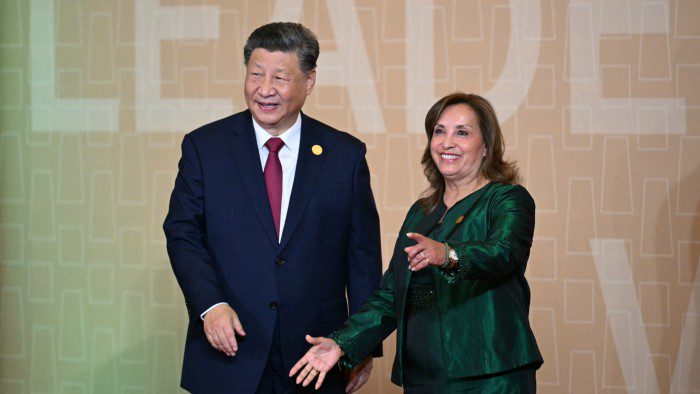Unlock the White House Watch newsletter for free
Your guide to what the 2024 US election means for Washington and the world
Two recent photographs tell the story of the battle for primacy between the US and China in one of the world’s most resource-rich regions.
In both images, President Xi Jinping stands front and centre, flanked by his Latin American host. President Joe Biden, on the other hand, lingers near the end of the back row in one picture and is absent from the other.
Naturally, there are official explanations. In the first picture at last week’s Apec summit in Peru, leaders stood in alphabetical order, which favoured China over a rival superpower starting with U. In the second, shot at this week’s G20 meeting in Rio de Janeiro, US diplomats said the group photo was taken early, before Biden had arrived.
Yet the summit photographs serve as metaphors for the eclipse of the US by China in Latin America, a region that Washington used to call its backyard.
World leaders at the Apec meeting in Peru pose in alphabetical order, which places the US at the back © Leah Millis/Reuters
The superpower contest matters because the resources at stake are vast. Latin America has 57 per cent of global lithium reserves, 37 per cent of the copper, nearly a fifth of the oil and almost a third of the world’s fresh water and primary forest.
Keenly aware of the region’s importance, Xi added a state visit to his schedule in Peru last week, heading a delegation of several hundred Chinese business people and inaugurating the first phase of what will be a $3.5bn giant port intended to revolutionise shipping from Latin America’s Pacific coast to China.
Biden, by contrast, announced nine Black Hawk helicopters for a $65mn anti-drug programme and a donation of second-hand trains from California for the Lima metro system.
“It was such a striking contrast,” said Michael Shifter, adjunct professor at Georgetown University. “You have this huge Chinese mega-port project that evoked Peru’s history going back to the Incas and seeking greatness. And then what Biden delivered was some more helicopters for coca eradication. That seems completely outdated and stale.”
In Brazil, the region’s biggest economy, it was a similar story. Xi was received with full honours in Brasília for a state visit after the G20, while Biden was flying home. The US leader visited the Amazon on his way to Rio and announced a $50mn donation to a conservation fund, while Xi was expected to focus on multibillion-dollar Chinese investments.
China’s trade with Latin America has mushroomed over the past two decades from $12bn in 2000 to $450bn in 2023. Beijing is now the main trading partner for most nations in the region and has the fastest-growing stock of investments. (Mexico, with its special access to the US market via USMCA, is an exception.)
Beijing has focused in recent years on investing in key South American sectors such as the mining of critical minerals, electricity generation and transmission, and digital and transport infrastructure.
Margaret Myers, an expert on China-Latin America relations at the Inter-American Dialogue in Washington, said 60 per cent of China’s investment in Latin America was focused on high tech sectors that were a priority for both sides. “There has been a real interest in engaging China, especially on these types of investments.”
Recommended
Alex Contreras, who was Peru’s finance minister while the Chancay megaport was being built, told the Financial Times that “any investment is welcome in a region which has an enormous investment deficit”. He added: “If you have to choose between no investment and Chinese investment, you will always prefer investment.”
Yet, despite frequent US expressions of concern about China’s advances in Latin America — General Laura Richardson, the former US commander covering the region, warned it was “on the 20-yard line to our homeland” — Washington’s response has been underwhelming.
The Americas Partnership for Economic Prosperity, an initiative touted by Biden as an answer to Beijing, was “all dressed up very nicely”, Shifter said. “But when it comes down to committing real resources, there’s nothing there.”
The return of Donald Trump to the White House looks likely to give China an even more dominant role in the region’s economic life.
Matias Spektor at the Getúlio Vargas Foundation in São Paulo saw little prospect of Trump boosting US trade and investment in the region in his second term.
“Trump’s promises go in the opposite direction,” he said, arguing tough rhetoric would pile pressure on Latin American countries to curb China’s presence, while Beijing would have an incentive to double down, leaving domestic politics in the region deeply divided. Spektor added: “It’s the worst possible world.”
Source link : http://www.bing.com/news/apiclick.aspx?ref=FexRss&aid=&tid=673ddb2085e74c2bb8b1b580bb43d176&url=https%3A%2F%2Fwww.ft.com%2Fcontent%2Fb9cfdae3-c276-4184-adbb-707c5e460fa7&c=5295135652871341979&mkt=en-us
Author :
Publish date : 2024-11-19 23:15:00
Copyright for syndicated content belongs to the linked Source.
